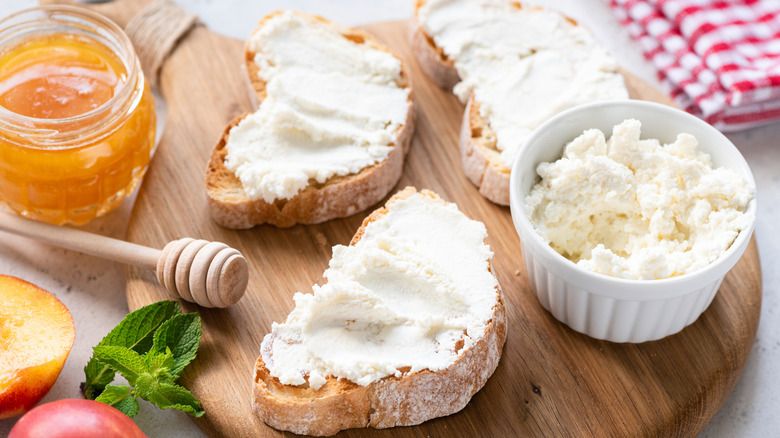The Fresh Cheese Ina Garten Always Makes Herself (And Never Buys At The Store)
Unlike the robust complexity that gives aged cheese its appeal, the draw of fresh cheese is its mild flavor, which may be accented with simple saltiness or tang. Fresh cheese is aged just briefly, if at all, and is best enjoyed not long after it's made. When celebrity chef Ina Garten wants fresh cheese, she opts for ricotta, and Barefoot Contessa ensures it's as fresh as possible, and the best way to do it is to make it herself.
Making your own ricotta may sound daunting, but it's actually easy, which is why Garten stopped getting store-bought. To make it, she brings one quart of whole milk, two cups of heavy cream, and a teaspoon of kosher salt to a boil, then turns off the heat and adds three tablespoons of white wine vinegar. This makes the milk curdle, separating the curds from the liquid whey. After one minute, she pours it into a cheesecloth-lined strainer in a bowl and lets it drain for about 20 minutes, periodically discarding drained whey from the bowl. What's left in the cheesecloth is ricotta. As the ricotta drains, it will become firmer, so adjust the time depending on the texture you want to attain.
Make ricotta with any whole milk except ultra-high temperature pasteurized (UHT), which organic milk can often be. The UHT process prevents the milk from separating and creating curds. You can also get away with 2% milk, but the ricotta won't be as creamy.
Try different acids and techniques for homemade ricotta
The key to making ricotta is the acid that makes the milk curdle. Ina Garten uses white wine vinegar, but lemon juice and white vinegar are also common. While white vinegar is neutral, white wine vinegar will impart some flavor, and the lemon juice will give the ricotta a light citrusy note. Try other vinegar varieties, like apple cider, red wine, and balsamic. Your ricotta won't be snowy white, but the flavor might make up for it.
Garten's recipe for homemade ricotta relies on a reliable, standard method, but recipes may vary. Some don't bring the milk to a boil but suggest heating milk until it's just about to boil, while others start heating milk with the acid already mixed in. They may let the curdling milk sit longer before draining and suggest spooning the milk into the cheesecloth, so it isn't forced into the openings, which might slow down the draining process. Experiment with different techniques to discover what works for you.
There are many ways how to use ricotta, but it will show its best spread on toasted Italian bread and paired with herbs, fruits like figs or berries, prosciutto, jam, or a drizzle of olive oil and balsamic. You can always go traditional and incorporate it into lasagna, ravioli, or cannoli, or even recreate Giada De Laurentiis' dip with ricotta, canned tomatoes, and basil. Alternatively, turn it into a dessert with a sprinkle of sugar and cinnamon and a drizzle of honey. Your ricotta even belongs in pancakes, and it can make a boxed cake a whole lot fancier.

